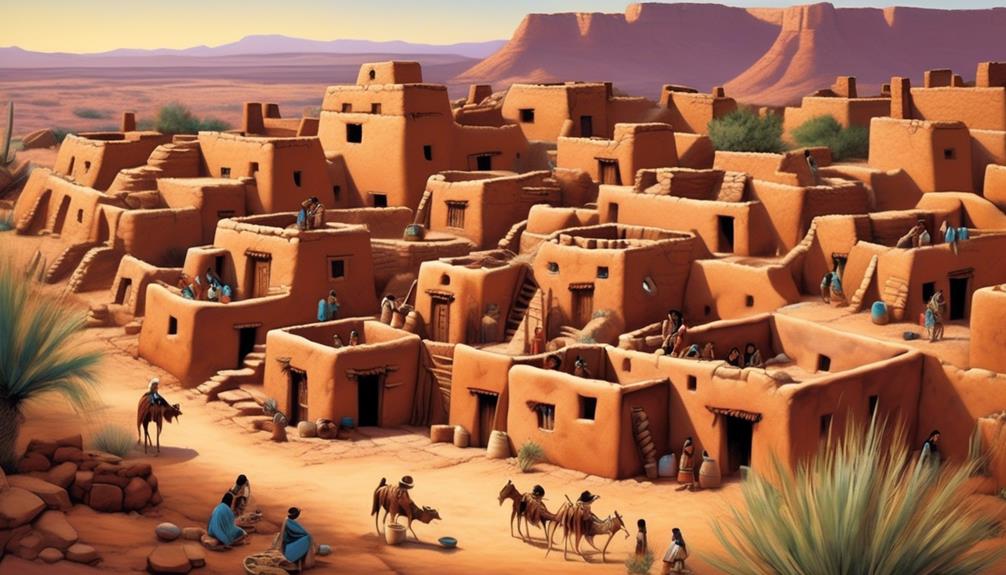Were you aware that the traditional attire of the Hopi tribe has been worn for more than a millennium? Their colorful and culturally rich heritage is widely recognized.
The attire of the Hopi people holds a deep significance, reflecting their history, beliefs, and identity.
But what exactly does the Hopi tribe wear, and what is the symbolism behind their clothing?
Join us as we explore the traditional attire of the Hopi tribe, uncovering the unique and meaningful elements that make up their rich sartorial heritage.
Key Takeaways
- Hopi clothing has a rich history spanning over a thousand years, incorporating traditional garments such as cotton kilts, cotton dresses, moccasins, and yucca fiber sandals.
- The introduction of sheep in the 16th century led to the adoption of wool in Hopi clothing, and over time, the tribe incorporated new materials and styles influenced by neighboring tribes and European settlers.
- Symbolism plays a significant role in Hopi clothing, with intricate embroidery, vibrant colors, and symbolic patterns representing elements of nature, the tribe's dependence on the natural world, and their values and beliefs.
- Contemporary Hopi fashion blends traditional motifs with modern patterns and designs, adapting to the complexities of the modern world while preserving cultural heritage. The traditional silhouette has evolved to incorporate modern cuts, tailoring, and garment construction techniques.
History of Hopi Clothing
The evolution of Hopi clothing reflects the cultural, social, and environmental influences that have shaped the tribe's attire over centuries.
Hopi clothing has a deep cultural significance, with each garment and accessory carrying symbolic meaning. Traditionally, men wore cotton kilts or breechcloths, while women donned cotton dresses with a woven belt. Both genders wore moccasins or sandals made from yucca fibers.
As the Hopi people are known for their intricate weaving techniques, textiles played a vital role in their traditional attire. The introduction of sheep by the Spanish in the 16th century led to the adoption of wool in their clothing, expanding their textile repertoire.
With the influence of neighboring tribes and European settlers, Hopi clothing began to incorporate new materials and styles, adapting to changing social and environmental factors. Despite these changes, traditional elements such as vibrant colors, intricate embroidery, and symbolic patterns continue to be integral to Hopi attire, preserving the rich cultural heritage of the tribe.
Traditional Hopi Attire for Men

Reflecting the cultural traditions of the Hopi tribe, men's traditional attire encompasses a blend of practicality, symbolism, and artistry.
Hopi men's clothing is characterized by its functionality for both everyday wear and ceremonial purposes. The traditional attire for men includes kahos, which are kilts made of cotton or wool and wrapped around the waist. These kahos are often adorned with intricate designs and patterns that hold symbolic significance within the Hopi culture.
Additionally, men wear a shirt known as a paltó, which is usually made of a dark fabric and features unique embroidery or designs.
For ceremonial garments, men don a manta, a type of robe that's often intricately decorated with symbols and motifs that hold spiritual meaning.
This attire is complemented by moccasins or boots and various jewelry pieces like necklaces, bracelets, and earrings.
The traditional Hopi attire for men not only serves as a means of clothing but also as a representation of their cultural heritage and spiritual beliefs, embodying the rich traditions and symbolism of the Hopi tribe.
Traditional Hopi Attire for Women
Adorning themselves in a vibrant array of garments, Hopi women's traditional attire reflects a rich tapestry of cultural significance and artistic expression. The traditional Hopi women's dress is characterized by its colorful and intricately embroidered cotton dresses, which are often adorned with traditional Hopi symbols such as katsinas, rain clouds, and corn stalks. These symbols hold deep ceremonial significance, representing fertility, abundance, and the spiritual connection to the natural world.
The attire also includes a brightly colored belt, typically made of woven cotton or leather, and adorned with silver concho belts that jingle as the women move. Additionally, Hopi women wear moccasins with colorful beadwork, showcasing exquisite craftsmanship and attention to detail.
The traditional Hopi women's attire is often worn during ceremonial dances and rituals, where the vibrant colors and symbolic designs play a vital role in connecting the wearer to their cultural heritage and spiritual beliefs. The attire reflects a deep sense of pride and reverence for tradition, embodying the resilience and cultural continuity of the Hopi people.
Symbolism in Hopi Clothing

Woven into the vibrant fabric of traditional Hopi attire for women are symbolic motifs that carry deep cultural and spiritual significance. Each element of the attire is rich with symbolism, reflecting the Hopi people's connection to their land, history, and spiritual beliefs. The patterns and designs on the clothing often represent elements of nature, such as clouds, water, or rain, which are essential for agriculture and are deeply revered in Hopi culture. These symbols serve as a reminder of the tribe's dependence on the natural world and their responsibility to steward the earth.
The colors used in the clothing also hold cultural significance. For instance, the color black represents the north and signifies the emergence and rebirth, while blue represents the west and stands for water and the sky. These colors aren't only visually striking but also carry layers of meaning that are integral to the Hopi way of life.
Furthermore, the intricate beadwork and embroidery found on Hopi clothing often depict traditional stories and ceremonies, serving as a visual representation of the tribe's cultural heritage. The symbolism in Hopi clothing not only adds to its aesthetic appeal but also serves as a powerful expression of the tribe's values, beliefs, and connection to the natural and spiritual worlds.
Contemporary Influences on Hopi Fashion

Contemporary influences have significantly impacted the traditional clothing and fashion of the Hopi tribe, introducing new materials, designs, and styles that reflect the evolving cultural dynamics of the modern world.
The modern influences on Hopi fashion can be observed through:
- Materials: Traditional Hopi clothing, once made primarily from cotton and animal hides, now incorporates modern materials such as wool, silk, and synthetic fibers. These new materials not only provide durability and comfort but also offer a wider range of colors and textures for clothing.
- Designs: Contemporary Hopi fashion often showcases a fusion of traditional Hopi motifs with modern patterns and designs. This cultural fusion reflects the influence of global fashion trends and the creative adaptation of traditional elements.
- Styles: The traditional silhouette of Hopi clothing has evolved to incorporate modern cuts, tailoring, and garment construction techniques. This blending of traditional and contemporary styles allows for greater versatility in everyday wear and ceremonial attire, catering to the practical needs of modern life while preserving the cultural heritage of the Hopi tribe.
The interplay of modern influences and cultural fusion has led to a dynamic shift in Hopi fashion, demonstrating the adaptability of tradition in response to the complexities of the modern world.
Frequently Asked Questions
What Materials Are Commonly Used in Traditional Hopi Clothing?
Materials commonly used in traditional Hopi clothing include cotton, wool, and leather. These materials are intricately woven or embroidered with traditional designs that hold deep cultural significance.
The color patterns used in Hopi clothing are often vibrant and symbolic, representing elements of nature and the spiritual beliefs of the tribe. These traditional garments are an important aspect of Hopi identity and are worn for both ceremonial and everyday purposes.
Are There Specific Colors or Patterns That Hold Special Significance in Hopi Clothing?
Colors and traditional designs in Hopi clothing are rich with symbolism and cultural significance. The use of specific colors and patterns often represents connections to nature, stories of creation, and spiritual beliefs. The intricate designs and vibrant colors in Hopi clothing reflect the tribe's deep-rooted traditions and historical narratives. These elements serve as a powerful expression of the tribe's cultural identity and heritage.
Do Different Hopi Villages Have Unique Styles of Clothing?
Different Hopi villages have unique styles of clothing that hold cultural significance. Each village has its own distinct designs and patterns that reflect their traditions and beliefs.
The clothing worn in these villages is a reflection of the community's identity and is often tied to specific ceremonies and rituals. These styles of clothing are deeply rooted in the history and heritage of each Hopi village, showcasing the diversity and richness of their culture.
Are There Any Special Occasions or Ceremonies That Require Specific Attire for the Hopi Tribe?
Special occasions and ceremonies hold great cultural significance for the Hopi tribe. During these events, the community dons ceremonial attire adorned with traditional designs. Each garment reflects the tribe's rich heritage and spiritual symbolism.
These unique outfits are meticulously crafted, showcasing the tribe's deep-rooted traditions. The attire worn during these special occasions not only represents the tribe's cultural identity but also serves as a visual manifestation of their spiritual beliefs and customs.
How Do Hopi People Learn the Traditional Methods of Making Their Clothing?
We learn traditional methods of making clothing through hands-on learning and traditional teaching. The knowledge is passed down from generation to generation, ensuring the preservation of our cultural practices.
Elders and skilled artisans play a crucial role in teaching the intricate techniques of creating our traditional attire. This method of learning not only imparts practical skills but also fosters a deep connection to our heritage and traditions.
Conclusion
In conclusion, the traditional attire of the Hopi tribe is a reflection of their rich history and cultural significance.
Like a tapestry woven with stories and symbols, each garment holds a deeper meaning that connects the wearer to their ancestors and the natural world.
While contemporary influences may have an impact on Hopi fashion, the essence of their traditional clothing remains a powerful expression of identity and heritage.









